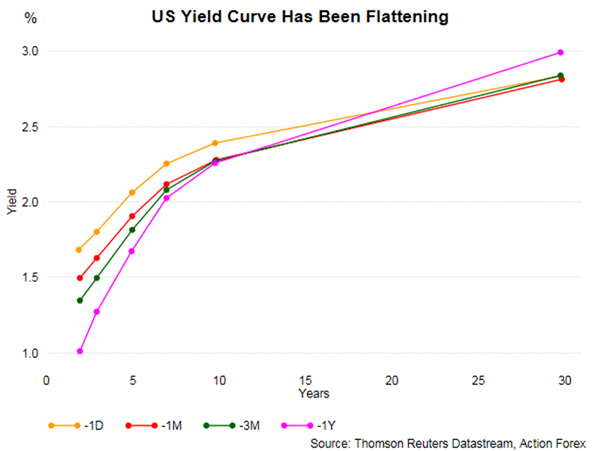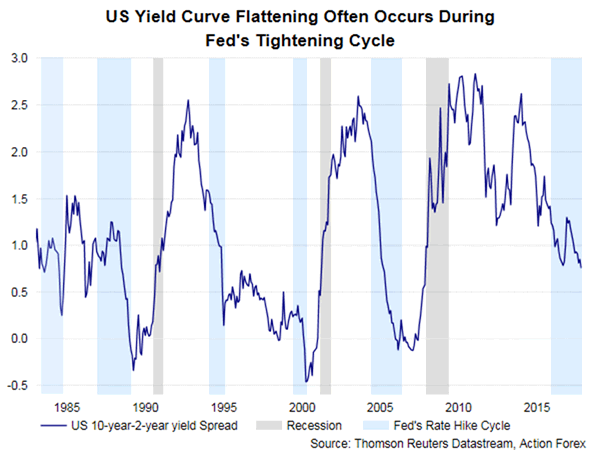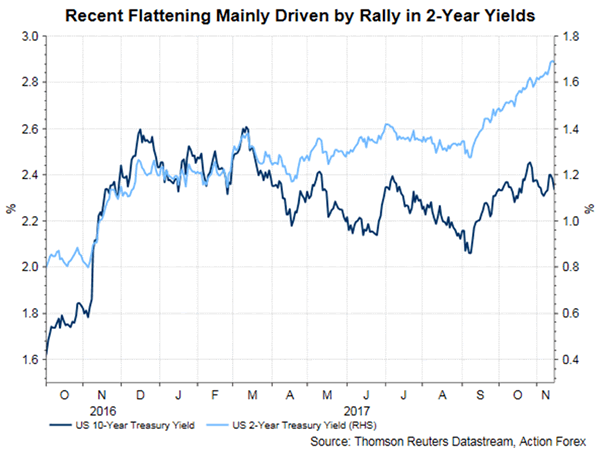The talk of the day is undoubtedly the flattening of US yield curve with the spread between the 10-year and 2-year yields fell to 64 bps, the lowest level since November 2007 on Thursday. Meanwhile, the spread between 30-year and 5-year yields also dropped below 75 bps, the lowest in about 2 week. Flattening yield curve has raised concerns as this is probably also a reason of diminished risk appetite this week, apart from disappointing global macro dat. Textbook knowledge suggests a normal yield curve is upward-sloping as yields for longer-dated investments are higher than shorter-dated ones. An inverted yield curve (short-dated yields exceed those of long-dated) is usually a signal of upcoming economic recession. A flat yield curve is the transitory period from a normal to an inverted curve. However, this interpretation does not necessarily hold true. For instance, US’ economic growth managed to avoid recession, despite a series of global economic crisis from 1995-2000, years after the sharp yield curve flattening from 1994 to 1995 (Second Chart).

Coincidence with Fed Tightening
Meanwhile, we notice that US yield curve flattens as the Fed is in the tightening cycle. The chart below shows that US 10-year and 2-year yield spread narrow significantly during the 5 Fed funds rate hike cycle since the 1980s. For instance, in the previous tightening cycle from June-2004 to June-2006 when the Fed increased the policy rate by +425 bps, the 10-year and 2-year yield spread plunged -157 bps. Yet, the extent of flattening, indicated by the narrowing of yield spread, does not necessarily increase with the number of rate hikes. The current rate hike cycle began in December 2015 as the Fed raised the policy rate for the first time since the global financial crisis. While missing its own guidance with only one rate hike in 2016, the Fed is on track to raise the policy rate for three times this year, followed more hikes in 2019. The tightening cycle, as possibly the yield curve flattening, has just begun.

Bear Flattening
The recent flattening is characterized as ‘bear flattening’, as the flattening of the yield curve is more driven by the rise in short-dated yields (e.g. 2-year yield), compared with ‘bull flattening’ which is driven by the fall in long-dated yields (e.g. 10-year yields). This phenomenon also happened in the previous three rate hike cycles (1994-95, 1999-00 and 2004-06). The chart below shows that the last yield curve steepness peaked in December 2016 and has flattened 70 bps since then (as of November 15). During the period, 2-year yield rose +49 bps while 10-year yields slipped -22 bps. The recent rally in 2-year yields to the highest in 7 years has clearly been driven by December rate hike expectations. CME’s Fed funds futures have fully priced in a rate hike next month over the past two days, compared with 98.2% chance last week and 88% last month. The latest inflation report has reinforced, if not intensified, such hope. While headline CPI in moderated to +2% y/y in October from +2.2% a month ago, this had been widely anticipated. Surprisingly, core inflation climbed +0.1 percentage point higher to +1.8%, marking the first increase since January.


Yield Curve and Inflation Expectations
Yield curve flattening also reflects the low inflation expectations in the US. Persistently subdued inflation has put the Fed in a dilemma in its rate hike decision. For many months, the Fed has admitted that inflation has stayed low. Yet, the members have decided to look through the weaknesses which are resulted from transitory factors. At the November FOMC meeting, the members indicated that ‘inflation for items other than food and energy [core inflation] remained soft’. They also noted that CPI measures ‘have declined this year and are running below +2%’. On net, the Fed continued to characterize the near-term risks to the economic outlook as ‘roughly balanced’, and it would continue ‘monitoring inflation developments closely’. We certainly do not expect the Fed to change the tone in December merely because of October’s upside surprise. Yet, the stronger-than-expected core CPI would inevitably justify the rate hike decision. A ‘bear flattening’ this time evidences that the market has been convinced by the Fed that its normalization policy would continue despite soft inflation.














